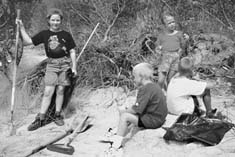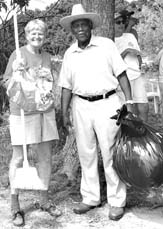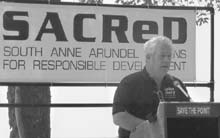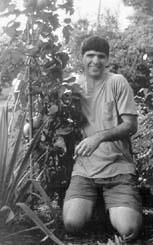
Dock of the Bay

Volume VI Number 29
July 23-29, 1998
Holding Fire: Franklin Point Peace Breaks Out
 Roxanne
Earley of Churchton, tleft, was one of many kids helping clean up. Jordon
Amos, 11, below at right, collected wood and metal and hauled it on his
bike back to Columbia Beach. Marilyn Ramsey of Idlewilde and Charles White
of Columbia Beach, bottom right, pitched in.Anne Arundel County Executive
John Gary, bottom left, pledged $3 million to help buy Franklin Point.
Roxanne
Earley of Churchton, tleft, was one of many kids helping clean up. Jordon
Amos, 11, below at right, collected wood and metal and hauled it on his
bike back to Columbia Beach. Marilyn Ramsey of Idlewilde and Charles White
of Columbia Beach, bottom right, pitched in.Anne Arundel County Executive
John Gary, bottom left, pledged $3 million to help buy Franklin Point.
 Armistice
Day came to Franklin Point last Saturday. July 18 marked the end to the
decade-long war over what is, in field general Michael Shay's words, "500
acres of the most beautiful habitat on this Shady Side peninsula we call
home."
Armistice
Day came to Franklin Point last Saturday. July 18 marked the end to the
decade-long war over what is, in field general Michael Shay's words, "500
acres of the most beautiful habitat on this Shady Side peninsula we call
home."
Starting the war was the fate of that beautiful 477 acres of Bay-fronted Southern Anne Arundel County woodland.
On the side of development was Washington D.C. developer and parking lot magnate Dominic Antonelli, who owns the property and had once summered at the Point. His vision has been a pricey subdivision, to be called Baldwin's Choice, of some 150 homes.
On the other side has been South Arundel Citizens for Responsible Development, SACReD, the grassroots army of neighbors organized by Shay, among others. Nature ruled their vision for what, in less poetic flights, they called the last tract of undeveloped land on the peninsula.
Battles were fought door-to-door, in road-side sign campaigns, in public hearings, in the permitting offices of Anne Arundel County and the Army Corps of Engineers. And in the courts. So hostile were the exchanges that Antonelli sued SACReD and some of its organizers, demanding $50 million for defamation. A jury in the District of Columbia agreed that some untrue words had been slung, but refused damages.
But that was war, and this is peace.
The treaty of Franklin Point, penciled in that sun-lit afternoon, binds those wounds.
"It's a win-win situation," proclaimed Antonelli's chief attorney, Jeffrey Harris, standing in for his out-of-town client. "From what I heard today, it's approaching critical mass," said Harris, as amicably as if the hatchet had never been unsheathed.
Nature's victory, if the deal holds, is nearly 500 acres on the densely developed Shady Side peninsula to be preserved as open space. Antonelli's victory is compensation, though not nearly so much as he had once sought, for his land - plus redemption. In sign, word and deed, praise poured down from erstwhile enemies and newfound partners as peace was celebrated with fine words, free food and the sweat of many brows.
"Mr. Antonelli is key," said Anne Arundel County Executive John Gary, introduced on the Point as the "person who's going to lead healing of the wounds of this war."
Gary, who is often criticized as overfriendly to development, came to the Point bearing the promise of gifts. "If this works out, coming from [my office] is a check for $3 million," pledged Gary, who is seeking re-election to a second four-year term as county executive.
In behind-the-scenes negotiations, Antonelli had reportedly agreed to sell the troubled property and lowered his price from near $15 to approximately $6 million.
Gary had earlier expressed growing interest in using county money to help preserve Franklin Point. At the peace celebration, he went on record as a buyer. "I never have any trouble doing what I say because the buck stops at my desk," he said - advising the gathering of rejoicing citizen activists to "hold everybody's feet to the fire to make sure they do what they say."
To make the purchase, the state of Maryland would have to contribute another $3 million. On hand to speak for state money were Senate President Thomas V. Mike Miller, House Majority Whip George Owings and Del. Virginia Clagett.
Gov. Parris Glendening, by way of a stand-in, sent this message:
"The governor has asked the Department of Natural Resources to take
the first steps to preserve this exceptional piece of property."
Passed round at the event were copies of letters to be sent to the governor, urging him to "publicly show your support and financial commitment to this critical project so citizens will know where you stand on this issue."
Once the governor signs on, all sides would next have to sit down at the table to frame a memo of agreement, Gary said.
The fine words went down as easily as the barbecue donated and served by Olde South Catering. The crowd was hungry for both, having spent a couple of hours capping the nearly done deal by picking up trash along the road, shared with the historically African American community of Columbia Beach, to the Point.
Piles of trash and waste plucked from woodland and wetland of Franklin Point, enough to fill a dump truck, stood as testimony to the grassroots commitment of the ordinary citizens who had served as foot soldiers in the war.
Among the clean-up crew, Southern High School students Cherie Peterson, 16, brother Robert Peterson, 15, and Helena McGuire, 16, had dredged a 20 foot piece of pipe out of the Bay near the Point. Submerged, it had been on the site of a small house Antonelli himself had owned in the late 40s and early 50s. Medievalists who write science fiction for fun, they "like battles of good over evil," McGuire said.
Perhaps even better are battles where both sides win. As will happen if community activist Gus Jackson, of Columbia Beach, gets his Armistice Day wish of "a check the next time we meet here, to turn promise into reality."
-SOM with M.L. Faunce
No Nettlesome Prediction: This Summer's Slime Could Be Slim
El Niño, you bring good news at last. Thanks to heavy rains and cool spring temperatures, scientists predict that sea nettles will not arrive in our part of the Chesapeake Bay in abundance until August.
![]() That early forecast from
the University of Maryland's Horn Point Environmental Laboratory in Cambridge
is supported by 30 years of observation by David Cargo, who is retired from
the Horn Point's sister facility, Chesapeake Biological Laboratory at Solomons.
That early forecast from
the University of Maryland's Horn Point Environmental Laboratory in Cambridge
is supported by 30 years of observation by David Cargo, who is retired from
the Horn Point's sister facility, Chesapeake Biological Laboratory at Solomons.
Why? For the same reason that tomatoes are slow in ripening: a cool, wet spring. More specifically, because of run-off. Cargo calls run-off the primary factor influencing nettles.
With this year's high run-off, Cargo predicts that "if you're seeing more than five nettles per day in Solomons, I'd be surprised."
Everyone knows that sea nettles, Chrysaora quinquecirrha, infest Bay waters each summer, plaguing swimmers and beachcombers alike with their stinging ways. Unlike most jellyfish, sea nettles prefer brackish waters, making the Bay and its tributaries a right nifty place to hang their tentacles. They have no natural predators here: sea turtles and species of nettle-chomping fish rarely venture up the Bay.
Furthermore, nettles eat their biggest competition for food, the comb
jellies. Then they multiply prodigiously in Chesapeake Bay, appearing here
in numbers found nowhere else.
What kind of numbers?
Consider these nettle reproductive facts: Sea nettles start producing eggs when they are about one inch across. The more they grow, the more eggs they produce. By the time females reach a respectable four-inch size, they're shedding about 40,000 eggs each day. Fertilized eggs form larvae that make their way to the bottom, where they attach themselves to hard surfaces, usually the underside of oyster shells. There, they grow into tiny polyps. In summer, the polyps bud off tiny nettles: one polyp can produce up to 45 baby nettles per season. That adds up to lots of knee-biting nettles.
Now consider their growth rate. While the baby nettles are small - 125 inch in diameter - they grow quickly. Nettles are mostly water and salt, with only 1 percent of their body weight taken up by solid stuff, which means a little food turns into a lot of nettle fast. What's more, as they grow, the nettles' ability to gather food grows, too, allowing them to grow even faster.
Finding a meal isn't a problem, either. Sea nettles feed mostly on copepods - microscopic crustaceans - but they also eat minnows, bay anchovy eggs, worms, mosquito larvae and comb jellies. In tributaries, sea nettles greedily consume up to 90 percent of the little copepods that might otherwise make a square meal for bay anchovies, menhaden and, in that way, rockfish and bluefish.
Also, sea nettles appear to feed and grow in the summer's oxygen-poor bottom waters, places fish can't live, giving them even more room to stretch their tentacles.
So, with a spacious, comfortable home, no predators and lots of food, you'd think Bay nettles wouldn't need our help. However, some researchers think people may in fact be partly responsible for the nettles' success. The Bay's ecology is complex, but there is evidence that increased amounts of nutrients in the Bay - waste products, fertilizers and other runoff - may make living a lot easier for nettles. Here's the argument: nutrients cause blooms of phytoplankton, single-celled plants that are favored by copepods, which are sea nettles' main dish. More food, more nettles. Just what we need.
So what's good about nettles?
More than we appreciate, said the University of Maryland's Jennifer Purcell. During the two weeks that oysters spend as free-swimming larvae, they are vulnerable to predators, including sea nettles and comb jellies. However, Purcell discovered that while sea nettles catch the larvae, they spit them out unharmed. Comb jellies, on the other hand, catch and eat the larvae. With their summer emergence in the Bay's tributaries - when oyster larvae are at their peak - sea nettles can virtually wipe out the comb jelly threat.
Exactly how much the nettles help is still up for debate, but it's nice to think that nettles, in one of nature's ironic twists, may help the very thing that can make Bay waters less attractive to them: oysters, our natural filtering system.
Just something to think about as you hop about in the surf, clutching your foot and cursing the Bay's bilious blobs, which, we regret to report, are beginning to appear in these waning days of July.
-Don Kehne
Detective Story: The Curious Case of the Tardy Tomato
photos by Sandra O. Martin Michael Kimlico of Fairhaven enjoys the bounty of his heavily producing tomato plants.
Red ripe from the vine, when will you be mine?
This spring, Reggie and Debbie Nutwell set out 3,000 tomato plants by hand -- 1,000 more than last year -- on their farm along Rt. 258 in Deale. Only in recent days have the plants begun producing for the Nutwells' roadside stand.
"The reason we have any tomatoes to sell at all is because we planted so many. They're very slow ripening this year," says Debbie Nutwell.
They say the best growers see ripe tomatoes by the Fourth of July. If that's the case, then growers in the middle Chesapeake region have something to learn.
Or is it the simply weather?
Finally, tomatoes are ripening in farm plots and in backyard gardens along the Chesapeake Bay. But seasoned growers are shaking their heads and some home gardeners are depressed by the slow-ripening fruits on their vines.
Meanwhile, crates of tomatoes are being picked nearly green on the Eastern Shore and shipped across the Bay Bridge to fill the demand. And people have been paying inflated prices - $1.98 a pound in some supermarkets.
For some people, summer doesn't begin until they taste their first homegrown tomato. Never are they fooled by the ultrahybrid imports grown with heavy fertilizer and organophosphate pesticides, alleged fruits that taste like soggy cardboard.
By this time most years, true aficionados are eating tomatoes nearly every meal: slices on the breakfast plate, on sandwiches for lunch and, in the evening, tomato steaks for dinner. (Then there's fried green tomatoes early and late.)
Vegetable expert Jon Traunfeld of the University of Maryland Cooperative Extension Service insists that this year isn't that much different than others. But he acknowledges that the weather -- a cool, rainy spring and now hot, dry periods -- might be slowing things a bit.
"If they are slow, it could be attributed to a crazy spring," he says. "When you put tomatoes in cool soil, roots don't get established quickly and the little microorganisms are too cold to work in the organic matter and feed the plant."
Then came protracted periods of rain, which deprived roots of oxygen and, in some cases, led to rotting and a failure to establish roots. The Agricultural Extension Service "experts" who spread black landscaping fabric had problems, too: The material trapped moisture, killing the roots not only of tomatoes but also of peppers and other vegetables.
When fruits were forming late spring, the temperature dropped to 50 degrees or less many nights. Traunfeld notes that growing weather early this summer was fairly good, but the conditions early have produced some malformed, cat-faced tomatoes and the sense among people that things are out of kilter.
In Lothian, Maurice Fowler says there's no question that tomatoes that usually arrive between July 4 and July 10 are late this year, about two weeks. His crop wasn't ready last week so he's been selling tomatoes from Caroline County on the Eastern Shore at his roadside stand at the intersection of Rts. 256 and 258.
Fowler knows plenty about farming: Tobacco is his main cash crop and besides tomatoes, he grows squash, cucumbers, eggplant, peppers and string beans. He has this advice for good-tasting tomatoes or, for that matter, any vegetable: "Keep it growing. If it hits a dry spell and it gets stunted, the crop doesn't have as good a flavor."
At Tracey's Landing, Purnell Franklin talked about his ripe tomatoes after picking two buckets: "These early ones are good, but catfaced," he said, referring to the puckered, lined appearance of tomatoes from blooms out in 50-degree nights.
At the Nutwell farm, they've grown tomato crops for four years on land that has been in the family for two centuries. Each year, the crop has been different; last year, they were harvesting eight to 10 boxes of tomatoes a day at this time. So far this year, it's been just a couple of boxes.
Moisture is what the tomatoes need now. "The tomatoes are starting to come in good now, but they'd be better if we got a soaking rain. Without rain, the skin gets thicker," Reggie Nutwell Sr. says.
And not only the weather has been a problem: Raccoons and groundhogs have been enjoying the tomatoes, taking small bites out of the early, ripe fruit. The deer are even worse pests, ruining sweet corn by nibbling away at the tassels.
The Nutwells take turns selling their produce from a cart they set up across the road from their farm. Often Reggie Sr. can be seen pulling the cart with an old tractor.
Finally, the tomatoes are coming, months after all the work of putting 3,000 plants in the soil by hand. "It's been a long time," Debbie Nutwell says.
For in-person answers to your gardening questions, ask the experts at University of Maryland Cooperative Extension Service. free 8am-1pm weekdays: 800/342-2507. Or browse the web for lots of curious information: www.agnr.umd.edu/users/hgic.
-M.L. Faunce, Kim Cammarrata and Staff
In Seattle, the Pacific Fishermen Inc. boatyard is being praised for taking steps to treat 100 percent of its wastewater on site before discharging clean effluent into the Seattle sanitary system. The company says it is saving money because it no longer has to hire a company to treat and haul away the wastewater ...
Indiana conservationists know when using a new Visa card that a portion of their purchase will go to the Indiana Natural Resources Foundation to protect public lands. We hope they know the interest rate, too ...
In Washington State, the Vancouver
Columbian is turning up the heat on personal watercraft. In an editorial
last week, the newspaper said that the jet ski "has become the cigarette
of aquatic sports, and a lot of people are tired of being subjected to the
secondhand smoke, noise, environmental problems and, sometimes, reckless
behavior" ...
Our Creature Feature has to do with the misfortunes of skunks who have a fondness for yogurt. Not just any yogurt, it turns out, but Yoplait yogurt, which comes in those funny-shaped containers with narrow tops and wide bottoms.
You may already have figured the problem: skunks cavorting about the countryside with blueberry yogurt containers stuck on their noses. This scene has repeated itself so frequently activists recently asked General Mills, which makes Yoplait, to redesign the containers.
The company said it was non-committal but insisted it had "no vendetta against skunks."
| Back to Archives |
Volume VI Number 29
July 23-29, 1998
New Bay Times
| Homepage |